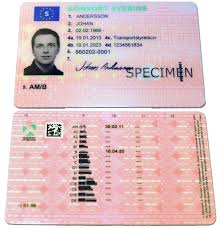Find Out More About Genuine Driver's License Online While Working From…
페이지 정보
작성자 Deloris 댓글 0건 조회 2회 작성일 25-04-28 09:00본문
The Rise of Genuine Online Driver's Licenses: Trends, Benefits, and Considerations
In an age where digital options are changing daily processes, acquiring a driver's license online has actually become a significantly popular alternative for many individuals. The convenience, effectiveness, and progressing innovation behind online licensing systems are enticing, however the principle of a "genuine" online driver's license necessitates analysis. This short article explores the patterns, benefits, C KöRkort OsäKert (Https://Pattern-Wiki.Win) and considerations connected with obtaining a genuine driver's license online.
 The Trends in Online Driver's Licensing
The Trends in Online Driver's Licensing
The shift towards digital services is apparent across various sectors, and transport is no exception. Many states and countries have actually begun to use online platforms where homeowners can look for, renew, or change their driver's licenses. A number of aspects have actually stimulated this trend:
Technological Advancements: Improvements in safe and secure online platforms make it much easier than ever to handle delicate info. Advanced file encryption and biometric technologies have begun to enhance user safety and the stability of online applications.
Pandemic-Driven Changes: The COVID-19 pandemic required many services to pivot online as physical offices closed or minimal in-person consultations. This expedited the adoption of online licensing procedures, exposing their prospective benefits.
Customer Preferences: Today's consumers prioritize convenience. The ability to request a driver's license from home or on-the-go resonates with people who value time-saving options.
Benefits of Obtaining a Driver's License Online
1. Convenience
Among the most considerable advantages of an online driver's license application is benefit. Users no longer have to schedule appointments, wait in long lines, or take some time off work. The entire procedure can frequently be finished from the comfort of home, as long as the person has Internet access.
2. Time Efficiency
Online applications can significantly minimize processing times. Many states have structured their digital systems to provide faster processing than conventional techniques. Users can typically track their application status in real-time, leading to greater openness and decreased stress and anxiety.
3. Boosted Security
While there are issues relating to online security, numerous online licensing platforms utilize robust security measures to secure user info. With secure connections and data encryption, candidates can feel positive in the safety of their individual information.
4. Ease of access
Online services cater to diverse populations, including those with mobility challenges or residing in remote areas. This availability enables a broader group to obtain their driver's licenses without the barriers traditionally connected with in-person applications.
Factors to consider When Applying for a Driver's License Online
While the benefits are compelling, there are also important considerations:
1. Preserving Authenticity
Acquiring a genuine driver's license online needs watchfulness. Applicants ought to just use official government websites to prevent frauds and fake licenses. It's necessary to verify that the digital platform is legitimate and safe before submitting personal information.
2. Regulative Compliance
Different regions have different guidelines regarding online applications. It's crucial to understand and KöPa KöRkort Utan Test Online adhere to local laws and requirements to make sure the license's validity.
3. Technology Access
Not everybody has equivalent access to innovation or the Internet. Those without reliable access might discover themselves left out from this procedure, highlighting an ongoing digital divide that must be dealt with.
4. Risks of Identity Theft
While numerous online platforms prioritize security, there is constantly a risk associated with sharing personal details online. Applicants ought to take preventative measures, such as using strong passwords, to help reduce these threats.
 Conclusion
Conclusion
The option to obtain a genuine driver's license online represents a significant improvement in how we communicate with government services. As innovation continues to progress, it's likely that the processes surrounding driver's licensing will become much more streamlined and efficient. However, it is vital for applicants to browse this landscape carefully, guaranteeing that they are informed, alert, and knowledgeable about best practices to secure their individual info. By doing so, they can delight in the benefits of this modern convenience, while reducing possible risks. In a world progressively dependent on digital services, c körkort online lagligt pris; https://writeablog.net/landnic39/how-new-drivers-license-changed-over-time-evolution-of-new-drivers-license, the journey to acquiring a driver's license is undoubtedly progressing.
In an age where digital options are changing daily processes, acquiring a driver's license online has actually become a significantly popular alternative for many individuals. The convenience, effectiveness, and progressing innovation behind online licensing systems are enticing, however the principle of a "genuine" online driver's license necessitates analysis. This short article explores the patterns, benefits, C KöRkort OsäKert (Https://Pattern-Wiki.Win) and considerations connected with obtaining a genuine driver's license online.
 The Trends in Online Driver's Licensing
The Trends in Online Driver's LicensingThe shift towards digital services is apparent across various sectors, and transport is no exception. Many states and countries have actually begun to use online platforms where homeowners can look for, renew, or change their driver's licenses. A number of aspects have actually stimulated this trend:
Technological Advancements: Improvements in safe and secure online platforms make it much easier than ever to handle delicate info. Advanced file encryption and biometric technologies have begun to enhance user safety and the stability of online applications.
Pandemic-Driven Changes: The COVID-19 pandemic required many services to pivot online as physical offices closed or minimal in-person consultations. This expedited the adoption of online licensing procedures, exposing their prospective benefits.
Customer Preferences: Today's consumers prioritize convenience. The ability to request a driver's license from home or on-the-go resonates with people who value time-saving options.
Benefits of Obtaining a Driver's License Online
1. Convenience
Among the most considerable advantages of an online driver's license application is benefit. Users no longer have to schedule appointments, wait in long lines, or take some time off work. The entire procedure can frequently be finished from the comfort of home, as long as the person has Internet access.
2. Time Efficiency
Online applications can significantly minimize processing times. Many states have structured their digital systems to provide faster processing than conventional techniques. Users can typically track their application status in real-time, leading to greater openness and decreased stress and anxiety.
3. Boosted Security
While there are issues relating to online security, numerous online licensing platforms utilize robust security measures to secure user info. With secure connections and data encryption, candidates can feel positive in the safety of their individual information.
4. Ease of access
Online services cater to diverse populations, including those with mobility challenges or residing in remote areas. This availability enables a broader group to obtain their driver's licenses without the barriers traditionally connected with in-person applications.
Factors to consider When Applying for a Driver's License Online
While the benefits are compelling, there are also important considerations:
1. Preserving Authenticity
Acquiring a genuine driver's license online needs watchfulness. Applicants ought to just use official government websites to prevent frauds and fake licenses. It's necessary to verify that the digital platform is legitimate and safe before submitting personal information.
2. Regulative Compliance
Different regions have different guidelines regarding online applications. It's crucial to understand and KöPa KöRkort Utan Test Online adhere to local laws and requirements to make sure the license's validity.
3. Technology Access
Not everybody has equivalent access to innovation or the Internet. Those without reliable access might discover themselves left out from this procedure, highlighting an ongoing digital divide that must be dealt with.
4. Risks of Identity Theft
While numerous online platforms prioritize security, there is constantly a risk associated with sharing personal details online. Applicants ought to take preventative measures, such as using strong passwords, to help reduce these threats.
 Conclusion
ConclusionThe option to obtain a genuine driver's license online represents a significant improvement in how we communicate with government services. As innovation continues to progress, it's likely that the processes surrounding driver's licensing will become much more streamlined and efficient. However, it is vital for applicants to browse this landscape carefully, guaranteeing that they are informed, alert, and knowledgeable about best practices to secure their individual info. By doing so, they can delight in the benefits of this modern convenience, while reducing possible risks. In a world progressively dependent on digital services, c körkort online lagligt pris; https://writeablog.net/landnic39/how-new-drivers-license-changed-over-time-evolution-of-new-drivers-license, the journey to acquiring a driver's license is undoubtedly progressing.
댓글목록
등록된 댓글이 없습니다.


